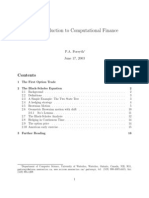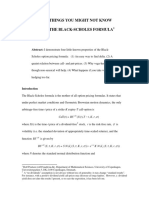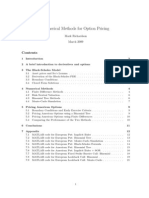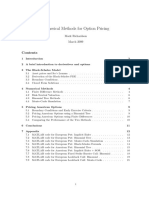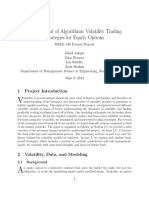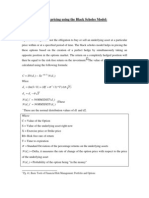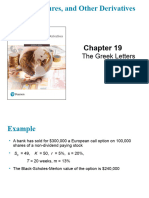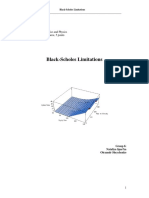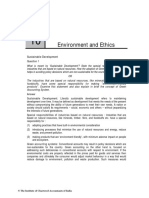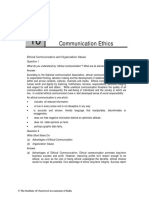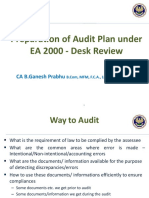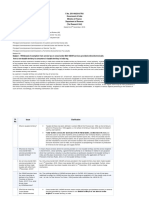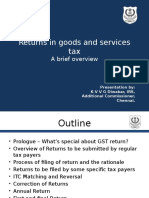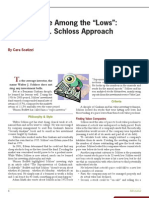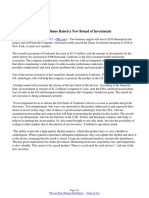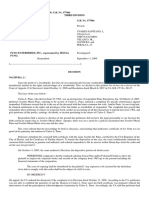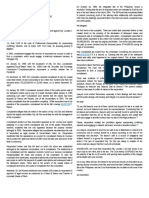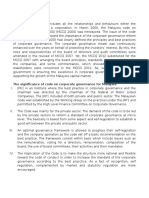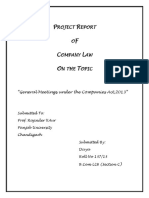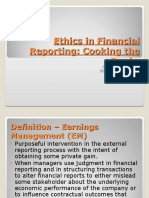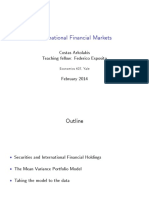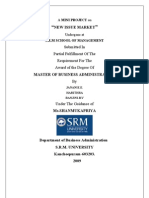Volatility ::
The Black-Scholes equation requires the knowledge of the spot rate r, the value of the
underlying S(t) at time t (which is known at the current time) and most of all the value of
the volatility of the underlying . Out of the above, the volatility is the most difficult
estimate.
One method is to use past data on the volatility of the underlying to estimate future ones.
Empirically it has been observed that the best estimates are given by considering historical
data in an interval
, long as the maturity time T of the option.
A better approach is to estimate it directly from the market option quotes. This implied
volatility
is calculated numerically given that the option value C(S,t) is
where
and
Generally the implied volatility gives a better estimate than that obtained by historical data.
The implied volatility is found to be a function of both strike price and maturity. The longer
the time to maturity, the larger the risk taken and thus the larger the implied volatility.
The most common dependence with strike price is given by a volatilitysmile (red curve in
the figure above), where the volatility is minimum when the strike price is given by the
initial value of the underlying. Other dependences such as volatility frowns (blue curve)
and smirks (green) are also observed.
�Another approach of dealing with volatility is to assume that it follows a Stochastic
Differential Equation (SDEs). We can follow a type of Black Scholes derivation (see article).
So we have our usual log normal SDE and one other for the volatility.
The two Brownian motions are correlated such that
, where is a measures
the correlation. Assuming that the functions p and q are given, how do we form a riskless
portfolio? We need to hedge our option V(S,t). Since we cannot hedge against , because it
is not offered in the market, we need to hedge against another option
on the same
underlying S. So as usual we create our hedging portfolio .
By Ito:
where our notation
we have that
denotes a partial derivative of V w.r.t. to time...,etc. From the SDEs
We substitute these relations into the above expansion for dV and a similar one for
. Substituting these into the expression for the change in portfolio value, given by
we find that to remove the randomness of the Brownian motion we need to choose
which gives
Now we can use the no arbitrage condition to equate
in a bank at a fixed rate r.
to the riskless return of investing
�We are then left with a risk neutral partial differential equation (PDE) involving partial
derivatives of V and . Defining the differential operator such that
the final PDE can be expresses as follows:
The left hand side is a function of V but not of , and vice versa for the right hand side.
This means that since the two options will in general have different strike price and maturity
dates, this equality holds if both sides are independent of the contract specifications. We can
thus equate this to a function of the independent quantities S,
and t.
For some arbitrary function
(S, ,t) we have that
is called the risk neutral drift rate of volatility, whilst the function
the market price of risk volatility (articles to follow).
is called
Black-Scholes for Dividend Paying Assets
Our previous derivation of the Black-Scholes equation assumes assets to be non-dividend
paying throughout their ownership. In reality assets do pay dividends,making them
attractive investments. The price of the asset is largely reflectant of future and past
payouts. A dividend is a share of the operating profits paid out to the shareholders at
regular intervals. If an organisation fails to make a profit, then no dividend payout out is
make for that period. The frequency and dates of the dividend payments vary from one
organisation to another. Dividends must be considered in pricing derivatives on dividend
paying assets (e.g. shares in a company) since after each dividend payment the price of the
asset drops by the dividend amount. Dividend forcasting is an art in itself and very crucial to
pricing derivatives. When including dividend payments in the Black-Scholes treatment we
must ask ourselves two question:
1) How large are the payments?
2) At what date and how often are they paid out?
The second of these two points opens the door to a more interesting question from a
mathematical perspective. Does one use a continous or discrete approach?
For practical reasons,most dividend payments are discretised to set intervals. If the intervals
are small enough, one can approach a continous limit. The closest example to a continous
dividend paying asset is money earnt on an interest bearing account.
�Assuming our asset to have continous dividend payments, we define the dividend yield
as the proportion of asset price S paid out per unit time. Therefore, in time
,a payment
of
is made. The random walk for the asset price becomes
is a constant in this case. This will alter our Black-Scholes PDE to
Our final conditions remain unchanged,
for a call option,and
for a put option.
Boundary conditions for a call option become
as before,and
as
Note: if
, then we recover our previous boundary condition where the option is worth
the asset price.
Similarly, the boundary conditions for a put option on a dividend paying asset are
and
as
The Black-Scholes equation for a dividend paying asset is solved the same way as the nondividend paying one, replacing r by
.
�Thus,the value of a European call option becomes
where
and
is as previously defined).
The Greek Letters - Delta ::
The Greek Letters or simply the "Greeks" are quantities representing the market
sensitivities of the options or other derivatives. Each Greek measures a different aspect of
the risk in an option position. Through understanding and managing these Greeks, market
makers, traders, financial institutions and portfolio managers can manage their risks
appropriately, whether they deal in OTC or exchange-traded options.
Delta
The delta of an option is defined as the rate of change of the option price w.r.t. the price of
the underlying asset. The delta of an option dependent on a single asset S is mathematically
expressed as:
For a European call option on a non-dividend-paying underlying, the value of the option is:
For a European call option on a non-dividend-paying share,
�Since
Now
i.e.
This gives
Deltas for call options are always positive, which means that a long (buy)call should be
hedged with a short (sell) position in the underlying, and vice versa.
Similarly, for a European put option of the same underlying, delta is given by:
Deltas for put options are always negative, which means that a long putshould be hedged
with a long position in the underlying, and vice versa.
Delta is between 0 and +1 for calls and between 0 and -1 for puts. The delta for the
underlying is always 1. A put option with a delta of 0.5 will drop 0.5 in price for each 1
rise in the underlying (i.e. increasingly out-of-the-money), a call option with the same delta
will rise 0.5 instead (i.e. increasingly in-the-money).
�Delta Hedging
If, for example, the share price is 10 and the call option price is 1 and the delta of the call
option is 0.5, an investor who has sold 12 call option contracts (options to buy 1,200
shares) can delta-hedge his/her position by buying 0.5 x 1,200 = 600 shares. A rise in
share price will produce a loss of 0.5 x 1,200 = 600 on the call options but a gain of 600
on the shares.
The delta of the portfolio can be determined by adding up all his/her positions.The delta of
the short option position is -0.5 x 1,200 = -600 and delta of the long share position is 1 x
600 = 600,thus his/her position has a delta of zero, this is referred as being delta neutral.
Unfortunately, delta-hedging only works for a short period of time during when delta of the
option is fixed. The hedge will have to be readjusted periodically to reflect changes in delta,
which could be affected by the share price, time to expiry, risk-free rate of return and
volatility of the underlying. Below we show how delta changes with the underlying share
price and time to expiry.
Variation of Delta with Share Price
Variation of Delta with share price (S) for European option on a non-dividend-paying share
with strike price of X. Here one can see that delta for in-the-money options is very close to
one and zero for out-of-the-money options.
�Variation of Delta with Time to Expiry
Variation of Delta with Time to Expiry (T) for European option on a non-dividend-paying
share with strike price of X. Red, Blue and Green lines denote out-of-the-money, at-themoney and in-the-money options respectively.





